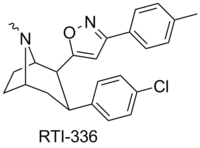RTI-177
RTI-177 | |
| 식별자 | |
|---|---|
| |
| CAS 번호 | |
| 펍켐 CID | |
| 켐스파이더 | |
| 켐벨 | |
| 화학 및 물리적 데이터 | |
| 공식 | C23H23CLN2O |
| 어금질량 | 378.90 g·190−1 |
| 3D 모델(JSmol) | |
| |
| |
DRI은 SERT.[1]RTI-177에micromolar한 체하는 것이phenyltropane 가족에서 RTI(-4229)-177(2β-(3-phenylisoxazol-5-yl)-3β-(4-chlorophenyl)tropane, β-CPPIT)은 합성 흥분제 마약, 실질적으로는 이것으로부터 다른 관련된 화합물 RTI-336보다 더 오래 20시간 이상의 조치에 대한 비정상적으로 긴 기간을 가지고 있다. 에서p-methyl 그룹의 부재에 의한 분자 [2]구조
"비선택적 모노아민 전달 억제제 RTI-126과 DAT 선택 억제제 RTI-150과 RTI-336은 모두 발생 속도가 더 빨랐고 작용 지속시간도 짧았다(4시간).이와는 대조적으로 비선택적 모노아민 전달억제제 RTI-112는 발병률(30~60분)이 느리고 작용 지속시간(10시간)이 길었다.DAT 선택 억제제 RTI-171과 RTI-177도 발병률(30–120분)이 느렸지만 RTI-171은 작용 지속시간(2.5시간)이 짧았고 RTI-177은 작용 지속시간(20시간)이 매우 길었다."[3]
갱신하다
인간 이외의 영장류에서 코카인에 비해 페닐트로판 코카인 아날로그 RTI-336 및 RTI-177의 보강강도가 낮다.
6가지 MAT 억제제 비교
| RTI | X | R | [3H]CFT | [3H]니소세틴 | [3H]파록세틴 |
|---|---|---|---|---|---|
| 콕 | — | — | 89.1 | 3298 (1986) | 1045 (45) |
| 177 | CL | 페닐 | 1.28 | 504 (304) | 2420 (220) |
| 176 | 나 | 페닐 | 1.58 | 398 (239) | 5110 (465) |
| 354 | 나 | 에틸 | 1.62 | 299 (180) | 6400 (582) |
| 336 | CL | p-자일 | 4.09 | 1714 (1033) | 5741 (522) |
| 386 | 나 | 안니소일 | 3.93 | 756 (450) | 4027 (380) |
린지 논문에서 RTI-177은 NET의 이중 억제제로 잘못 간주되었지만, 이는 나중에 잘못된 것으로 판명되었다.[citation needed]
"In acute toxicity studies in male rats, 3β-(4-chlorophenyl)-2β-[3-(4’-methylphenyl)isoxazol-5-yl]tropane (RTI-336) possessed an LD50 of 180 mg/kg after oral administration, compared with 49 mg/kg for RTI-177 (unpublished results, Howell 2005; Table 9).이러한 결과는 RTI-336이 RTI-177보다 더 사전 임상적 개발에 적합한 후보임을 시사했다.[2]
또한 체외 시험 결과에 기초하여 예측되는 것만큼 이질성 화합물의 효력이 크지 않다.
참조
- ^ Lindsey KP, Wilcox KM, Votaw JR, Goodman MM, Plisson C, Carroll FI, et al. (June 2004). "Effects of dopamine transporter inhibitors on cocaine self-administration in rhesus monkeys: relationship to transporter occupancy determined by positron emission tomography neuroimaging" (PDF). The Journal of Pharmacology and Experimental Therapeutics. 309 (3): 959–69. doi:10.1124/jpet.103.060293. PMID 14982963. S2CID 39794215. Archived from the original (PDF) on 2010-06-11.
- ^ a b Carroll FI, Howard JL, Howell LL, Fox BS, Kuhar MJ (March 2006). "Development of the dopamine transporter selective RTI-336 as a pharmacotherapy for cocaine abuse". The AAPS Journal. 8 (1): E196-203. doi:10.1208/aapsj080124. PMC 2751440. PMID 16584128.
- ^ Kimmel HL, O'Connor JA, Carroll FI, Howell LL (January 2007). "Faster onset and dopamine transporter selectivity predict stimulant and reinforcing effects of cocaine analogs in squirrel monkeys". Pharmacology, Biochemistry, and Behavior. 86 (1): 45–54. doi:10.1016/j.pbb.2006.12.006. PMC 1850383. PMID 17258302.


